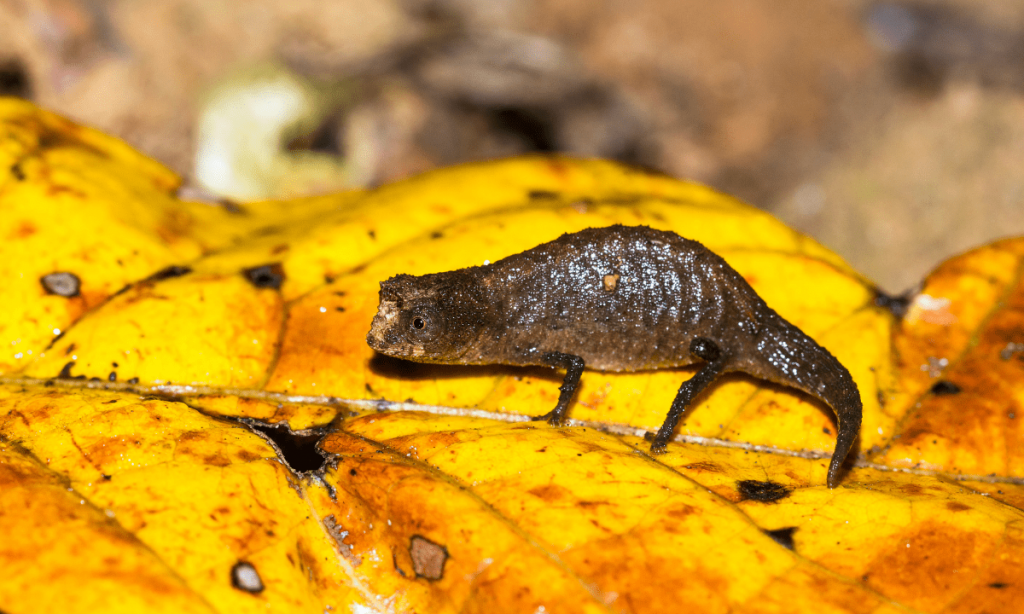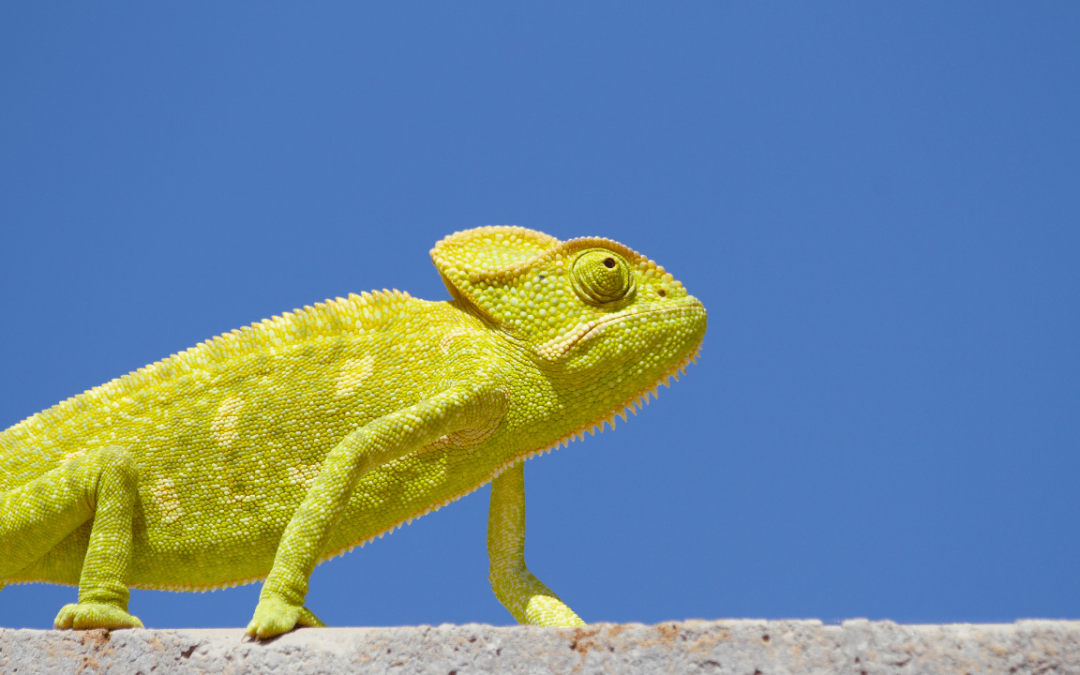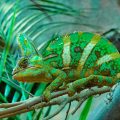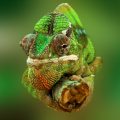Table of Contents
Fascinating, unique, magical and creative! These are some of the most picked descriptive words used in describing chameleons. And there is a great chance that you, as a kid; as well as everybody else have got in awe looking at them in the zoo, and on television. In this article, you’ll learn fascinating information about this well-known color adapting chameleons!
What Are Chameleons?
Chameleons are a distinctive and highly specialized clade of Old World lizards. They have a massive family of over 202 species. This animal comes in a variety of colors; with many types of it having the capacity to change color, which is what the ability they are popularized about.
Other characteristics of these interesting creatures are having zygodactylous feet, that have toes fused in opposed bundles of two and three; and having them work likely as tongs; a kitchen utensil. They also have acrodont dentition, their teeth being attached to the edge of their jaw; they also have eyes that move independently of each other and atrophied venom glands. The glands produce harmless traces of venom that reside on their long, slender projectile tongue.
They have horns on their brow as well as their snout, and larger species have a prehensile tail.
These lovely creatures are adept in climbing and visual hunting; and they are found in warm habitats that range from rainforest up to desert conditions. It is no secret how well they can adjust to their living environment
Why and How Do They Change Their Color?
We grew up in awe watching chameleons mold their color to their surroundings, it is quick, it is fascinating. This is because they have the ability to alter their skin coloration. Different species of chameleons can vary their coloration and pattern using fusions of pink, blue, red, orange, green, black, brown, yellow, light blue; turquoise as well as purple. Their skin has a superficial coating that contains pigment, and beneath it are cells with tiny guanine crystals.
The process of changing their color is actively tuning in the phatonic response of a lattice of tiny specimens of guanine nano-crystals residing in s-iridophores. This tuning; caused by a still unknown mechanism; can alter the wavelength of light that is reflecting from the crystal, which then changes the color of their skin.
What Is the Importance of a Chameleon’s Color – Changing Ability?
Their color change occurring in them has functions in camouflage; which they utilize commonly in social signaling and in reacting to temperature; and other conditions. The relative importance it has varies with the on-hand circumstances, as well as the kind of chameleon we are talking about. Their ability to color change allows the signaling of a chameleon’s physiological condition and intention; which they project on other chameleons.
Because chameleons are to be ectothermic, another reason why they alter their coloration is to regulate their body temperature. Darker colors to either absorb light and heat, to increase their body temperature. Conversely, lighter colors reflect light and heat that will stabilize or lower their body antipodes. Also, chameleons tend to show brighter colors when they are showing aggression to their same species; and they project darker colors in displaying submission or giving up.
Their color palette has evolved because of evolution as well as our changing environment. For instance, those who live in forests have a more defined and vivid palette; and as soon as they are transferred to living in a desert, the palette will gradually fade, giving off a basic, brown, and scalded palette.
Amazing Facts You Need to Know About Chameloens
Chameleons do not camouflage
The biggest mistake most people make about these exotic animals is that they change their color because their environment dictates them to do so, just what camouflage will look like. However, it holds no factuality in it.
In all honesty, chameleons change their color because of their mood; alternation of lights; temperature as well as the weather and humidity of the environment, and many other instances occurring in their very environment. For instance, in the wild, dominant attractive males generally project brighter hues; while submissive less attractive males might be showing darker hues of browns and gray. It is believed that women chameleons also respond to their suitors by changing their color in front of them if they want to accept or reject them.
Chameleons have eyes in the back of their heads
Although not in the literal sense, they are able to move their eyes; separate and independent of one another, and do so in 180 degrees. This means they can perceive the full 360 in instances when they need to. This comes useful from protecting themselves from predators that want to come behind them; as it gives a better chance to scarper before they are about to get caught.
Chameleons prefer a warm, tropical environment
There exist 59 species of this lovely animal on the island of Madagascar; and they are found nowhere else, and they account for over a quarter of chameleons’ 202 species. A warm environment for them like rain forest nourishes their health best, and the heat the sun gives actually provides health benefits to them, such as vitamin D; and better, brighter, and more structured scales.
The options are unlimited, for their different shapes and sizes
By length, the largest chameleon is the Malagasy giant chameleon that is measured almost 70 cm, and at the other end of the scale; we have the Brookesia micra chameleon that grows at a maximum of 30 millimeters.
And everything in between? Exists and you can have lots of options when you are to pet one. You may prefer larger as they look dominant as well as cool, almost fearful. Smaller versions of chameleons are undoubtedly cute and endearing, playful and fascinating to observe- almost too good to be true.
Chameleons’ tongue is in the extreme
Aside from their tail, there are some species of chameleons that have tongues that can exceed twice the length of their body. It consists of both muscles and bones; which is really thrilling as they can go around and grab their prey in just split seconds, securing no chance of getting away from them.
They have an unusual diet
The majority of chameleons thrive by eating insects, with foliage and fruits in the wild. Some larger species of them are likely to eat up to 50 large crickets, throughout their day. There are those who opt for meat, being carnivorous. This means them, eating small birds, and as fearful as it sounds, they also feast on one of their kind; when it is smaller than it.
They love to hang out on trees, they are so-called tree huggers
Most chameleons you will find are likely setting up a camp in trees, and are highly immersed as they are developed to traverse in branches and trunks. They have five toes; and each foot that are grouped into bigger bunches, with those toes on the hind feet that are reversed in position. These unique feet allow for them to grip on rough; and sometimes narrow branches faster and at ease, moreover aiding by the sharp claw on each toe.
In addition to this, they also have prehensile tails. This feature allows them to be highly adapted to dripping into branches; and allows for arboreal locomotion, or in simple terms, a life living in the trees. And how can they not? Their tails are able to curl several times around a branch, without problems of falling off. They are extremely balanced and comfortable.
Male and female chameleons look different from each other.
Males typically have horns and spikes that are missing female ones. These horns and spikes are not just for show, although they look attractive. These horns and spikes have saved them in protecting their territory from another one of their kind. Their spikes, specifically, aid in blending them well on their environment.
Sharp eyes, is also a great advantage they have
For a lizard, they hold quite a great set of eyes. Their eyes have developed both on helping them in catching their prey and in simultaneously; helping them escape from their predators. What is fascinating is that they can focus their eyes exceptionally well, meaning they can judge distances and spot prey as far as 10 meters.
In addition to this, chameleons also can perceive ultraviolet light that is not visible to us humans and UVB actually benefits and helps them become more fertile, sociable and at optimum health; both in the wild and in captivity. They might hold great eyesight, however, they lack a crisp sense of hearing. Chameleons can only hear noises that range 200Hz and 600Hz. These creatures are peaceful, in their own little world.
Chameleons do not live very long and take a while to hatch
Most female chameleons dig a hole to put their eggs in and let it develop between 4 to 12 months to successfully hatch, with some species taking almost 2 years. The number of eggs depends on the species; with some ranging from at least 3 to as many as 200 all at once.
And yes, they do not live very long, in fact, they hold the title for the shortest lifespan of a living reptile. They live somewhere between 1 and 10 years and mostly, all those that live in the wild, live for a longer period of time.
Popular Types of Chameleons

You so far may hold interest in tackling the specificity of chameleons. Well, let us waste no more time and discuss the most popular types of chameleon that not only stand out because of their appealing demeanor but also take into consideration if they make a great pet. So far, the list is looking good and on point.
Panther
Starting off strong, we have Panthers. These chameleons are stunning, extremely beautiful, and have the most variable and insanely vivid color patterns. Truthfully enough, they are the first on the list of most colorful chameleon species.
Their popularity of course comes from their jaw-dropping looks you can get lost in, but also with the ease of care and their tolerance for handling. Panthers often have a stripe along their side, and they can mold into any color you can imagine. From shades of green to yellow, to vibrant neon blues, and everything fun in between.
They do not need intensive care, and their needs are basic, attainable, and can fit any lifestyle. They are sociable and will likely bond with you, but also are okay with being left alone so long that their basic needs, with few wants, are met. Likewise, they love handling and interaction. And lastly, it is voted ranked 1, for being the most beginner-friendly chameleon pet owner.
Veiled
Coming on to the number 2 stop is Veiled chameleons, another cult’s favorite, especially beginners, as they are the easiest type of chameleon to care for. So long as their basic husbandry needs are attained, they thrive and prosper as pets.
The only downside is that they are not as happy as being held, compared to other species of their kind, and they are not the most vibrant, in showcasing their hues. However, they are still very endearing. Their base color is green, and they are known for having vertical stripes of yellow-brown and pale blue colors.
Jackson’s
Three-horned chameleons are what this next species is called, because they are the most interesting and unique looking chameleon, having had three horns on the top of their head. This occurs only in the make version.
Their horns as well as their small size is what makes them famous. As for the color, they lean towards basic, and instead of a variety of colors, they offer solid green with stripes of darker brown, as well as green markings.
Parson’s
Going over this species, yes, they are giants of the chameleon world. They are the largest individuals of chameleons, and reaching as far as 70 cm. These creatures hold amazing colors and are extremely variable in them, and their pattern. Chameleons have combinations of green, blue, white, yellow, as well as muted brown. Not only that, but they also have large dark diagonal stripes residing on the sides of their body. They are white most commonly, with green stripes surrounding its being.
Ambanja Panther
This is definitely one you should not miss out on. It is voted as the most glamorous chameleon as they have an extremely bright electric blue coloration that is just straight-up stunning. With their amazing body color comes appealing shades of reds, greens, and purples stripes. Moreover, ambanja is advantageous due to its large size, as well as its noticeable long prehensile tail.
These creatures have established a community of enthusiasts preaching how they are so fascinating to watch. They are not intimidating, you can hold them, and they would not be bothered, they are very social. Needs are attainable, and they are fairly low maintenance, for such a stunning and one-of-a-kind pet, that you might typically pay lots of attention to.
FAQs
Which species of chameleon is the bubbliest and most likable?
In fact, there is no one that is the bubbliest, likable, and even the one standing out friendlier than others since it mainly accounts for their own distinct personalities. Chameleons in general are not really fond of bonding too much as cats and dogs would, and it is best to not purchase one if you are in an assumption of them sitting on your shoulder all day.
How can a chameleon be tamed?
As I have said earlier, each of them has its own personality, and whatever you do does not necessarily transform your chameleon into a friendlier, tamed version of it. However, hand feeding is one of the best things you can do to win your chameleon’s trust and get it to be more comfortable and open with you. You are recognizable in their eyes, so your efforts will not be wasted.
Why am I seeing chameleons that do not color match things placed to them, like a t-shirt?
Contrary to popular thinking, chameleons do not change their colors just to match any background being placed on them. They change hues because of their moods, and they actually have a set of colors they can use, varying on the different species. They can, however, mimic their color to blend in with their environment. For instance, emitting darker tones because they are surrounded by darker plants, but they ultimately cannot change to blend in their environment exactly, and accurately.
Do they drink water?
They do, however they do not need a large amount of it but does require constant access to it. A chameleon living in the wild gets their daily water fix by sipping water off the leaves and in captivity, they do prefer missing them with water, or at least their vivarium.
Do chameleons make any sound?
Many species love to make a hissing sound, loud ones if they are feeling threatened or angry in their own kind or something in their environment.
Do chameleons make good pets?
Chameleons are undoubtedly amazing creatures, so far with what we have been discussing, but in all honesty, they are not the best pets for everyone. Sure, there are some to be beginner-friendly, and they are fairly low maintenance, their care requirements are specific, yes they are easy to conduct, but they are specific.
Because the care is unique, caregivers are expected to be consistent, otherwise, you are setting up your very own pet for vulnerable dangers. With this, it is clear they only make great pets, if and only if they have been blessed with the right circumstance. Let’s look at some essential things you need to know before owning one.
Chameleon Care Tips
- Chameleons need a big enclosure. Though they are generally small lizards, they need a tall cage and plenty of foliage to climb and navigate around. It is to be noted that it must have branches and mimic the natural environment as much as possible.
- Chameleons abide by a strict diet. They are insectivores and anything other than that, they will not care to eat, and they might also be compromising their health.
- Chameleons can be very sensitive. If you are a first-time, reptile pet owner, chameleons can be a challenging first reptile to own, with species that are small, they can get sick very easily, so a close watch is a must. You must really be eager and are teachable to handle them with care otherwise, you are not worthy of owning one of them.
- Chameleons need veterinarian care too. This often comes across as challenging because you would want to really find a vet who has exotic species expertise. Before owning, you must have at least three options of exotic vets to look out for in case some moving will take place.
- They are quite expensive. Their price speaks for how unique they are, and it can be a lot of money depending on their species. So, you will be sacrificing a good amount that can be utilized in other areas of your life. Although, it’s not money that counts, the actual willingness and actual connection you want to have in petting not just chameleons but any animal.
Ready to Own One?
Chameleons got it all, the looks, the fascinating features, and the advantages. The discussion we have shared definitely enriched and enlightened all there is to know about this fascinating creature.






 Author and long-time animal lover. Sharing knowledge on pet care through experience and the written word.
Author and long-time animal lover. Sharing knowledge on pet care through experience and the written word.